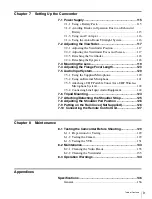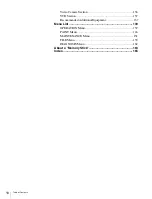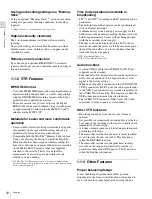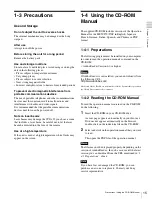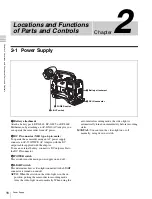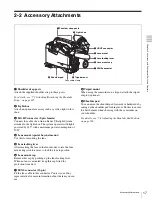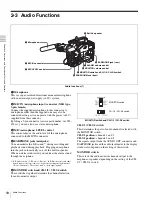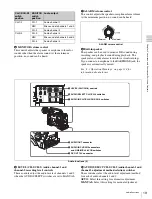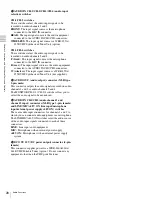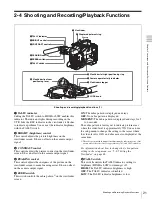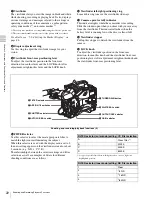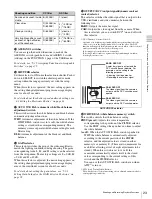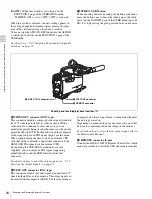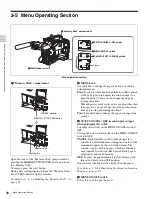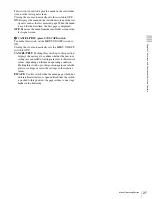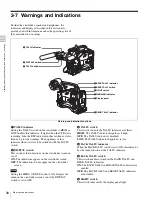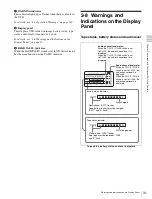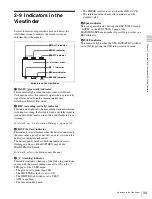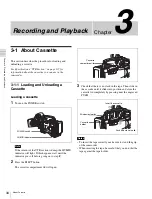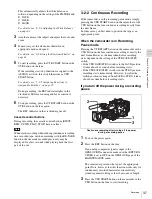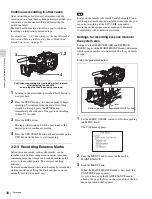
23
Shooting and Recording/Playback Functions
Cha
p
te
r 2
Loc
a
tio
ns
a
nd F
unc
tions
of
P
a
rts
a
nd Cont
rol
s
o
ASSIGN 1/2 switches
You can assign the desired functions to each of the
ASSIGN 1 switch (push button) and ASSIGN 2 switch
(sliding) on the FUNCTION 1 page of the USER menu.
For details, see “5-3-5 Assigning Functions to Assignable
Switches” on page 95.
p
SHUTTER selector
Set this selector to ON to use the electronic shutter. Push it
down to SELECT to switch the shutter speed or mode
setting within the range previously set with the setup
menu.
When this selector is operated, the new setting appears on
the setting change/adjustment progress message display
area for about 3 seconds.
For details about the shutter speed and mode settings, see
“4-2 Setting the Electronic Shutter” on page 63.
q
AUTO W/B BAL (automatic white/black balance
adjustment) switch
This switch activates the white balance and black balance
automatic adjustment functions.
WHT:
Automatic adjustment of the white balance. If the
WHITE BAL switch is set to A or B, the white balance
setting is stored in the corresponding memory. The
memory stores a separate white balance setting for each
filter setting.
BLK:
Automatic adjustment of the black set and black
balance.
r
GAIN selector
This selector switches the gain of the video amplifier to
match the lighting conditions during shooting. The gains
corresponding to the L, M, and H settings can be selected
from the setup menu. The factory settings are L = 0 dB, M
= 9 dB, and H = 18 dB.
When this selector is adjusted, the new setting appears on
the setting change/adjustment progress message display
area of the viewfinder screen for about 3 seconds.
For details about setting the gain values, see “5-3-1
Setting Gain Values for the GAIN Selector Positions” on
page 92.
s
OUTPUT/DCC (output signal/dynamic contrast
control) selector
This selector switches the video signal that is output to the
VTR, viewfinder, and video monitor, between the
following two.
BARS:
Outputs the color bar signal.
CAM:
Outputs the video signal from the camera. When
this is selected, you can switch DCC
1)
on and off with
this selector.
1) DCC (Dynamic Contrast Control)
Against a very bright background with the iris opening adjusted to the
subject, objects in the background will be lost in the glare. The DCC
function will suppress the high intensity and restore much of the lost detail
and is particularly effective in the following cases.
•Shooting people in the shade on a sunny day
•Shooting a subject indoors, against a background through a window
•Any high contrast scene
OUTPUT/DCC selector
t
WHITE BAL (white balance memory) switch
This switch controls the white balance setting.
PRST (preset):
Adjusts the color temperature
corresponding to the position of the FILTER selector.
Use the PRST setting when you have no time to adjust
the white balance.
A or B:
When the AUTO W/B BAL switch is pushed to
WHT, the white balance is automatically adjusted
according to the current position of the FILTER
selector, and the adjusted value is stored in either
memory A or memory B. (There are two memories for
each filter, allowing a total of eight adjustments to be
stored.) When this switch is set to A or B, the
camcorder automatically adjusts itself to the stored
value corresponding to the current settings of this
switch and the FILTER selector.
You can use the AUTO W/B BAL switch even when
ATW
1)
is in use.
1) ATW (Auto Tracing White Balance)
The white balance of the picture being shot is adjusted automatically for
varying lighting conditions.
Shooting condition
CC filter
ND filter
Sunrise and sunset; inside
studio
B (3200K)
1 (clear)
Clear skies
C (4300K) or
D (6300K)
2 (
1
/4 ND) or
3 (
1
/16 ND)
Cloudy or raining
D (6300K)
1 (clear) or
2 (
1
/4 ND)
Very bright conditions such
as snow, at high altitudes,
or at the seashore
C (4300K) or
D (6300K)
3 (
1
/16 ND) or
4 (
1
/64 ND)
BARS, DCC OFF
A color bar signal is output and the
DCC circuit does not operate. For
example, use the setting for the
following purposes.
• Adjusting the video monitor
• Recording the color bar signal
CAM, DCC OFF
The video signal from the camera is
output, and the DCC circuit does not
operate.
CAM, DCC ON
The video signal from the camera is
output, and the DCC circuit operates.
Summary of Contents for MSV-970
Page 5: ...5 ...
Page 168: ...168 Index Index ...
Page 170: ...Sony Corporation MSW 970 970P SY 3 863 920 03 1 Printed in Japan 2006 11 13 2005 ...

